LOS ANGELES — “I didn’t know how to be a mom,” Lisa Galvan said. “I was used to being by myself. It was really hard for me to adjust and even for the kids to adjust because I never was around. So when I came back out [of rehab] they gave them back to me, and within a month I started using again.”
By the time Galvan was 20, she had three children and had been using meth for seven years. She had been a drug addict for far longer than she’d been a mother, and when she tried to get sober, she found out she needed more than just substance abuse treatment before she could properly care for her kids.
 These days the nation is on high alert, for good reason, about the impact of drug abuse on children and foster care systems across the nation. The national conversation is focused on the epidemic-level abuse of heroin and opioids, but the scene in LA, where Galvan lives, is a bit different.
These days the nation is on high alert, for good reason, about the impact of drug abuse on children and foster care systems across the nation. The national conversation is focused on the epidemic-level abuse of heroin and opioids, but the scene in LA, where Galvan lives, is a bit different.
“There are concerning trends, but the opioid epidemic hasn’t touched LA County the way it has other parts of the country,” said Gary Tsai, medical director and science officer for LA County’s Department of Public Health Substance Abuse and Control division, citing increases in emergency room visits and hospitalizations related to opioid use.
The Public Health Department did report that admissions to publicly funded substance abuse treatment programs for opioid abuse almost doubled between 2005-10, but treatment admissions for heroin abuse are going down in the region, according to the National Institute of Drug Abuse. The spike in opioid use has not resulted in corollary jumps in foster care numbers in the region. In fact, despite a slight uptick (about 1 percent) between 2012 -14 (the most recent year with available data), the rate of children in foster care in LA County has dropped significantly (by 8,000 kids) during the past decade.
[Related: Is U.S. Opioid Crisis Straining State Child Welfare Systems?]
When and how we use painkillers is culturally influenced, Tsai said, and Americans consume pharmaceutical painkillers at a far higher frequency than other cultures. Noting that LA is a uniquely diverse American city, he suggested that “the heterogeneity of our population may be protecting LA from the epidemic.”
This certainly isn’t to say, though, that substance abuse doesn’t play a role in child welfare in Los Angeles — people here just tend toward different drugs. In LA, when children are removed from their parents for drug-related reasons, it’s categorized as “general neglect,” which encompasses all negligence-related cases. This makes it tough to monitor which drugs are most impacting the numbers of children entering the child-welfare system but anecdotal evidence shows that the drug of choice is meth, according to Alejandra Gandarilla, a supervisor for the county’s Drug Court program.
Drug Court, a treatment option for parents under investigation by the Department of Children and Family Services (DCFS) for reports of substance-related abuse or neglect, is seeing positive results using a wraparound-type treatment model. Parents who lose custody for drug- or alcohol-related offenses are typically court ordered to a six-month treatment program, but the Drug Court, one of more than 600 publicly funded treatment programs in the county, is a voluntary, more intensive 12-month option that boasts a higher success rate than the court-ordered option, according to Gandarilla.

Courtesy of Los Angeles County Dept. of Family and Child Services
Drug Court’s graduation ceremonies, like this one from May 2016, brings together parents, kids and service providers to celebrate successful completion of the course.
When asked about eligibility requirements for the Drug Court, Gandarilla insisted, “First and foremost, they have to admit they have an issue with substances.” It’s not for parents who just want to be sober long enough to get their child back, but for those who truly want to transition to a sober lifestyle, she said.
The Drug Court is a collaborative effort from the LA County Board of Supervisors, Superior Court, District Attorney, Public Defender, Sheriff, Probation Department, and the Substance Abuse Prevention and Control office of the Department of Public Health. Drug Court’s approach is much more hands-on than the standard six-month program.
“Once a family is involved with the DCFS court system, they will have a detention hearing within 72 business hours from detention and then a disposition hearing, usually about 45 days after the detention hearing. Thereafter, the families will attend court every six months for a status review hearing,” Gandarilla explained. “The difference with Drug Court clients is that they still adhere to the same timelines but in addition to those timelines they will have a Drug Court hearings monthly or bimonthly with their entire team being present in order to continue their support.”
The team collaborating around each Drug Court client includes a social worker, a substance abuse counselor, the client’s attorney, the minor’s attorney and the hearing officer. Drug Court works with only one judge, who knows each case intimately.
“I love the judge, the Drug Court judge,” Galvan exclaimed. “When I went back to court after the breakdown that I had he was nonjudgemental, like ‘You had another slip, get back on track.’”
Tsai praised the collaboration between judicial and clinical parties as a major reason why Drug Court has been proven so effective. “We don’t have any other health conditions where judges say you need this treatment for this amount of time,” he reasoned.
The California Hispanic Commission on Alcohol and Drug Abuse’s Latino Family Center in Montebello provides a one-stop shop for Drug Court’s services. Clients come in for drug testing one to three times weekly and attend both individual and group sessions with treatment counselors two to three times per week. Regular attendance at Alcoholics Anonymous or Narcotics Anonymous is also required, including working with a sponsor.
Galvan had attempted sobriety and even gone through court-ordered treatment before getting enrolled in A Better Me through Drug Court. She knew going into it that it would be a more stringent option, but another failed attempt seemed more daunting than the extra check-ins.
“Some of us need those extra eyes keeping watch,” she said with a chuckle. She said the support system she found through Drug Court and A Better Me was what made the difference between other treatment programs she’d tried.
Even after completing the yearlong treatment regimen, Drug Court clients participate in a mandatory aftercare program intended to wean them from services provided under Drug Court supervision and make sure they’re ready to handle their new sober lifestyle more independently.
Services of the aftercare program address parts of parents’ lives closely intertwined with their substance use, such as domestic violence counseling and parenting classes. Living with a parent who struggles with substance abuse is “closely associated” with emotional instability and behavioral issues in children, according to Kathleen Piché, public affairs director for LA County’s Department of Mental Health.
There’s significant research praising wraparound treatment approaches, though in the purview of DCFS, wraparound programs are most often focused on the abused or neglected child. The idea of using a wraparound model to help rehabilitate parents so they can safely care for their children seems to be showing success in this small-scale model in LA.
“We know that if we mandate treatment, it can work,” Tsai said. “But studies show that having services tailored to individual needs works better.”
By Gandarilla’s count, between May 2015 and May 2016, the Drug Court had about 55 clients enrolled. Of those, only two dropped out, and 10 left after regaining custody upon completing the minimum six months of treatment required by courts for reunification. The rest either are still within their yearlong enrollment or have since graduated.
For Galvan, the vital support she found with Drug Court and A Better Me didn’t stop after she graduated. When she would have a bad day, or need to process some problems, she would stop by the Latino Family Center just to chat with staff. Before long, she was hired on as an administrative assistant and now gets to see others go through the same transformation she did. She calls the opportunity “a blessing.”
“It’s amazing, you know, now I’m able to experience it,” Galvan said. “We see women come in and they’re broken, just all skinny and they seem defeated. Within a couple weeks they’re completely different.”






























